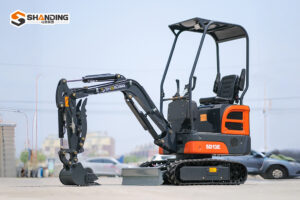Wheel loaders are indispensable in the construction industry, known for their versatility and efficiency in handling a variety of tasks. These powerful machines can significantly boost productivity on job sites by efficiently moving materials, loading trucks, and performing other essential functions. In this article, we will explore how to effectively utilize wheel loaders to enhance construction efficiency, covering best practices, key features, and practical tips.
Understanding Wheel Loaders
Wheel loaders are heavy equipment machines used primarily for moving, loading, and transporting materials such as soil, gravel, sand, and debris. They are equipped with a large front bucket attached to hydraulic arms, which allow for lifting and carrying substantial loads. Wheel loaders come in various sizes and configurations, making them suitable for a wide range of construction applications.
Key Features of Wheel Loaders
- High Lift Capacity: Wheel loaders are designed to handle heavy loads, making them ideal for moving large quantities of materials quickly and efficiently.
- Mobility and Speed: With their four-wheel drive and robust tires, wheel loaders can navigate rough terrains and move quickly across job sites, reducing transport time and increasing overall efficiency.
- Versatile Attachments: Wheel loaders can be equipped with various attachments such as forks, grapples, and snow plows, enhancing their versatility and allowing them to perform multiple tasks with a single machine.
- Advanced Control Systems: Modern wheel loaders feature advanced control systems and ergonomic operator cabins, ensuring precise handling and operator comfort, which contributes to better productivity and safety.
Best Practices for Utilizing Wheel Loaders
- Proper Training for Operators: Ensuring that operators are well-trained and familiar with the machine’s controls and capabilities is crucial. Skilled operators can maximize the efficiency and safety of wheel loaders, reducing the risk of accidents and downtime.
- Regular Maintenance: Keeping wheel loaders in top condition through regular maintenance is essential for optimal performance. Routine checks and timely repairs can prevent breakdowns and extend the machine’s lifespan, ensuring consistent productivity.
- Choosing the Right Size: Selecting the appropriate size and model of a wheel loader for the specific tasks at hand is vital. A machine that is too small may not handle the workload efficiently, while an oversized loader can be less maneuverable and consume more fuel.
- Optimizing Load and Carry Techniques: Using proper load and carry techniques can enhance efficiency. Operators should aim to load the bucket fully and transport materials in the shortest possible path to minimize travel time and fuel consumption.
Practical Tips for Enhancing Efficiency
- Strategic Planning: Plan the layout of the job site to minimize the distance wheel loaders need to travel. Position materials and dumping areas strategically to reduce travel time and improve workflow.
- Utilizing Attachments: Make the most of the available attachments to diversify the functions of wheel loaders. For instance, using forks for material handling or grapples for debris removal can save time and reduce the need for additional machinery.
- Fuel Management: Implementing efficient fuel management practices, such as monitoring fuel usage and avoiding excessive idling, can significantly reduce operational costs and improve overall efficiency.
- Leveraging Technology: Modern wheel loaders often come equipped with telematics and GPS systems that provide real-time data on machine performance, location, and usage. Utilizing this technology can help in monitoring productivity, identifying inefficiencies, and making data-driven decisions to enhance operations.
Case Study: Improving Efficiency with Wheel Loaders
Consider a construction site where the primary task is to move large quantities of soil and debris. By strategically placing dump trucks closer to the excavation site and using high-capacity wheel loaders, the project manager was able to reduce the cycle time for each load. Additionally, the use of advanced telematics allowed for real-time monitoring of the loaders, enabling proactive maintenance and minimizing downtime. As a result, the overall productivity of the site increased by 20%, demonstrating the significant impact of effective wheel loader utilization.
Conclusion
Wheel loaders are powerful assets in the construction industry, capable of significantly enhancing efficiency and productivity. By understanding their key features, implementing best practices, and leveraging modern technology, construction companies can maximize the potential of wheel loaders. Proper training, regular maintenance, and strategic planning are essential to ensure these machines operate at peak performance, ultimately leading to more efficient and cost-effective construction projects.




